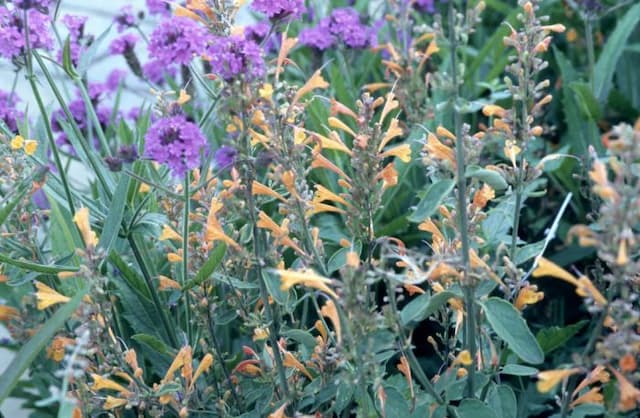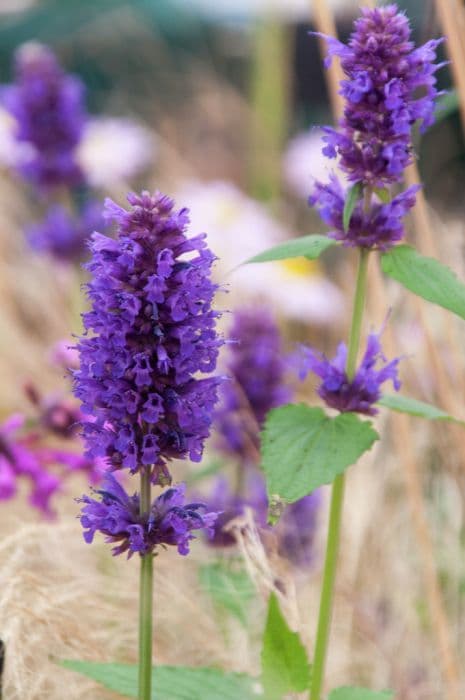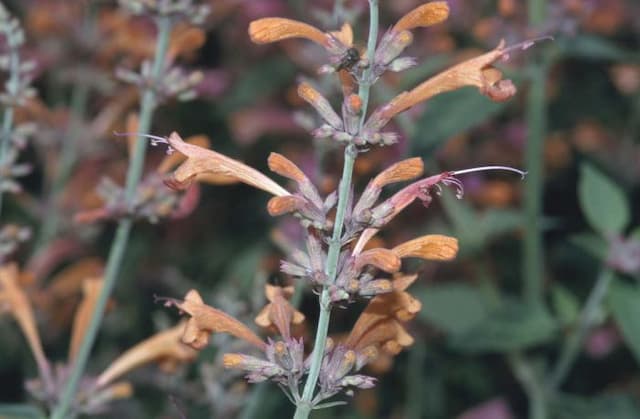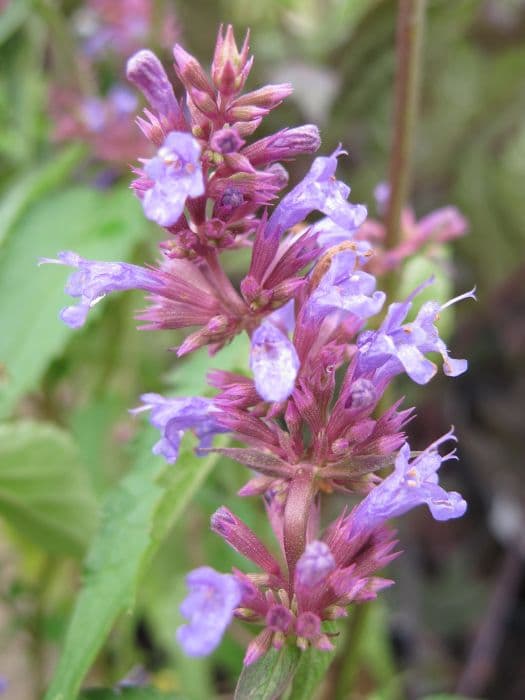Wild Thyme Thymus serpyllum 'Minor'

ABOUT
Thymus serpyllum 'Minor', commonly known as wild thyme or creeping thyme, is a low-growing, mat-forming perennial herb. The plant boasts a dense carpet of tiny, oval to needle-shaped leaves, which are aromatic when crushed. These leaves are often a deep green but can take on a grey-green hue depending on the environment and can sometimes appear slightly fuzzy. Throughout the growing season, the foliage provides a consistent groundcover that is both fragrant and attractive. Adding to its ornamental appeal, wild thyme produces small, tubular flowers that can range in color from pale pink to lavender, and these are nestled among the leaves in tight clusters. The blossoms are a magnet for bees and other pollinators, making the plant not only a visual delight but also beneficial for a garden's ecosystem. The flowers give the plant a soft, almost frothy appearance when in full bloom, and they contribute to the herb's charm and popularity among gardeners. Wild thyme's overall form is spreading and it hugs the ground closely, creating a tapestry that is often used in rock gardens, as a ground cover, or between stepping stones in paths. Its creeping stems can root where they touch the ground, allowing the plant to spread efficiently and cover soil with its verdant and fragrant foliage. Despite its delicate appearance, wild thyme is known for its toughness and can withstand some degree of foot traffic, making it a versatile addition to landscaping projects. The aesthetic of this plant is often described as both wild and delicate, with a rustic charm that enhances its surrounding space. Its resilience and low maintenance requirements make it a favorite among plants that offer visual appeal without the need for constant care.
About this plant
 Names
NamesFamily
Lamiaceae.
Synonyms
Breckland Thyme, Wild Thyme, Creeping Thyme, Elfintime.
Common names
Thymus serpyllum var. minus, Thymus serpyllum subsp. minus.
 Toxicity
ToxicityTo humans
Thyme (Thymus serpyllum 'Minor') is generally recognized as safe for human consumption when used in cooking as a culinary herb, and there are no widely reported toxic effects from ingesting this plant in typical amounts. However, consuming it in excessive quantities could potentially lead to digestive upset due to its strong active compounds.
To pets
Thyme (Thymus serpyllum 'Minor'), when consumed in small, culinary amounts, is not considered toxic to pets such as dogs and cats. However, large amounts might cause mild gastrointestinal upset. As with any non-food plant, introducing thyme to your pet's diet should be done cautiously and with the guidance of a veterinarian.
 Characteristics
CharacteristicsLife cycle
Perennials
Foliage type
Evergreen
Color of leaves
Green
Flower color
Purple
Height
3 inches (7.62 cm)
Spread
18 inches (45.72 cm)
Plant type
Herb
Hardiness zones
4
Native area
Europe
Benefits
 General Benefits
General Benefits- Aesthetic Appeal: Thymus serpyllum 'Minor', commonly known as wild thyme, adds beauty to gardens with its small, dense, cushion-like foliage and purple-pink flowers.
- Low Maintenance: Wild thyme is drought-resistant and typically requires minimal care once established, making it a good choice for low-maintenance landscaping.
- Ground Cover: Its spreading habit helps stabilize soil and reduce erosion, making it an effective ground cover for sunny areas.
- Culinary Use: Leaves are edible and can be used as a culinary herb, adding flavor to a variety of dishes.
- Attracts Pollinators: The flowers of wild thyme attract bees and butterflies, promoting biodiversity in the garden.
- Fragrance: The plant emits a pleasant scent when its leaves are crushed, providing aromatic benefits to the garden space.
- Lawn Alternative: It can serve as a low-growing alternative to traditional grass lawns, reducing water usage and mowing needs.
 Medical Properties
Medical Properties- Antiseptic - Thyme has been traditionally used as an antiseptic, due to its thymol content, which can help prevent infection and aid in wound healing.
- Expectorant - It is believed to be effective in relieving coughs and symptoms of respiratory conditions by helping to expel mucus.
- Antispasmodic - The herb may help in reducing spasms, for example, in cases of whooping cough or menstrual cramps.
- Antioxidant - It contains various compounds that can act as antioxidants, potentially protecting cells from damage caused by free radicals.
- Carminative - Thyme may assist in relieving digestive issues such as gas and bloating due to its carminative properties.
- Antifungal - It has historically been used for its antifungal properties, particularly in combating fungal infections such as athlete's foot.
- Antimicrobial - Due to the presence of thymol and other essential oils, it may have the ability to fight against certain bacteria, viruses, and other microbes.
- Anti-inflammatory - Thyme possesses anti-inflammatory properties, which might be beneficial in reducing inflammation in the body.
 Air-purifying Qualities
Air-purifying QualitiesThis plant is not specifically known for air purifying qualities.
 Other Uses
Other Uses- Groundcover: Thymus serpyllum 'Minor', commonly known as creeping thyme, is often used as a low-growing ground cover that can fill spaces between stepping stones and pavers due to its hardy and dense growth habit.
- Lawn Alternative: It serves as an eco-friendly lawn alternative, being drought-resistant and requiring less maintenance than traditional grass.
- Fragrance Source: Creeping thyme releases a pleasant scent when walked on, making it a popular choice for sensory gardens or paths.
- Culinary Decoration: Its small, decorative leaves and flowers can be used to add visual appeal and a mild thyme flavor to culinary dishes.
- Erosion Control: It can help to stabilize soil and prevent erosion on slopes or in areas prone to soil degradation.
- Herbal Sachets: The dried leaves and flowers can be used in herbal sachets to provide a natural fragrance in drawers and closets.
- Companion Planting: Creeping thyme may be planted alongside vegetables and other herbs to create a beneficial planting scheme that can deter certain pests.
- Bee and Butterfly Attraction: The plant's flowers are a source of nectar for bees and butterflies, promoting biodiversity in the garden.
- Decorative Pots: Creeping thyme can be planted in decorative pots and allowed to drape over the sides for an attractive display.
- Green Roofs: Due to its low-growing nature and tolerance of poor soil, it is ideal for cultivating on green roofs, where it can thrive with minimal care.
Interesting Facts
 Feng Shui
Feng ShuiThe Creeping Thyme is not used in Feng Shui practice.
 Zodiac Sign Compitability
Zodiac Sign CompitabilityThe Creeping Thyme is not used in astrology practice.
 Plant Symbolism
Plant Symbolism- Strength and Courage: Thymus serpyllum 'Minor', commonly known as wild thyme, is often associated with strength and courage due to its robust nature and ability to grow in tough conditions.
- Healing: Wild thyme has medicinal properties and has been used historically to treat various ailments, symbolizing healing and restorative powers.
- Bravery: In some historical contexts, wild thyme represents bravery, possibly stemming from its use by knights in the Middle Ages who would embroider it into their scarves as a sign of courage.
- Purity and Cleanliness: The antiseptic properties of thyme associate it with purity and cleanliness.
- Passing of Time: Because thyme is an evergreen and has a long history of human use, it can symbolize the passage of time and enduring qualities.
- Affection: In the language of flowers, wild thyme can represent affection, suggesting a deep bond or fondness between people.
 Water
WaterCreeping thyme requires moderate watering, and it is important to allow the soil to dry out between waterings. A good rule of thumb for the Creeping Thyme is to water it once every one to two weeks, providing about one inch of water each time. The frequency of watering should be adjusted depending on weather conditions, with less water required during rainy periods and more during droughts. It is important to avoid overwatering as this plant is drought-tolerant and too much moisture can lead to root rot. When watering, aim to soak the soil thoroughly to a depth of at least several inches to ensure that the water reaches the roots.
 Light
LightCreeping Thyme thrives best in full sun to partial shade. The ideal spot for this plant is a location where it can receive at least six hours of sunlight daily. However, if you live in a particularly hot climate, providing some afternoon shade will help protect the plant from excessive heat stress. Avoid deep shade, as insufficient sunlight can lead to poor growth and less flavorful leaves.
 Temperature
TemperatureCreeping Thyme is hardy and can tolerate a range of temperatures, making it a versatile garden plant. It can survive winter temperatures down to about -30 degrees Fahrenheit, while in the summer, it can handle heat well, up to 90 degrees Fahrenheit. The ideal growing conditions for Creeping Thyme are between 60 and 70 degrees Fahrenheit.
 Pruning
PruningPruning Creeping Thyme can help maintain its shape and encourage denser growth. The best time to prune is in the early spring or immediately after flowering to stimulate new growth and prevent the plant from becoming woody. Trim back up to one-third of the plant's size to keep it neat, and to promote a flush of fresh leaves. Pruning once a year is typically enough for this low-maintenance plant.
 Cleaning
CleaningNot needed
 Soil
SoilWild Thyme, also known as Thymus serpyllum 'Minor', thrives best in well-drained soil with a pH ranging from neutral to slightly alkaline, ideally between 6.5 and 7.5. A soil mix with equal parts of sand, loamy garden soil, and compost is recommended to provide adequate drainage and fertility. It's important to avoid heavy clay soils and to ensure the soil is not too rich, as Wild Thyme prefers less fertile conditions.
 Repotting
RepottingWild Thyme or Creeping Thyme should be repotted every 2 to 3 years to refresh the soil and provide room for growth. It's best to repot in the spring, just before the growing season begins, to minimize stress on the plant.
 Humidity & Misting
Humidity & MistingCreeping Thyme is tolerant of a wide range of humidity levels and generally does well in average home humidity conditions. It does not require high humidity and can withstand dry air, making it a versatile plant for various environments.
 Suitable locations
Suitable locationsIndoor
Provide Creeping Thyme with bright light and well-drained soil indoors.
Outdoor
Plant Creeping Thyme in full sun and well-draining soil.
Hardiness zone
4-9 USDA
 Life cycle
Life cycleThymus serpyllum 'Minor', commonly known as wild thyme or creeping thyme, begins its life cycle as a seed, typically germinating in the spring under ideal temperatures and moisture conditions. Once the seedlings emerge, they develop into small, woody-based perennials with fine, hair-like roots that spread out to form a dense, mat-like ground cover. During the growth stage, the plant produces small, oval leaves and in early to mid-summer, it blooms with tiny, usually lilac or purple-colored flowers that are attractive to bees and other pollinators. After pollination, the flowers develop into small nutlets (seeds) capable of producing new plants. Throughout the growing season, creeping thyme expands by sending out runners that root at nodes, further contributing to its dense growth habit. In winter, the plant becomes dormant, but as a hardy perennial, it can survive cold temperatures and regrow the following spring, completing its lifecycle.
 Propogation
PropogationPropogation time
Spring-Early Summer
Thymus serpyllum 'Minor', commonly known as wild thyme, is most effectively propagated through stem cuttings. The ideal time for taking cuttings is late spring to early summer, when the plant is in active growth. To propagate, choose a healthy stem with new growth and cut a piece about 2 to 4 inches (5 to 10 centimeters) long. Remove the leaves from the lower half of the cutting and dip the cut end in rooting hormone powder to encourage root development. Insert the cutting into a well-draining potting mix and ensure the soil remains moist but not waterlogged. Covering the pot with a plastic bag can create a greenhouse effect, maintaining humidity around the cutting. Roots usually develop within a few weeks, after which you can transplant the cutting to its final location.







![Bugle [Black Scallop]](/_next/image?url=https%3A%2F%2Fplants-admin.emdemapps.com%2Fimages%2Fplants%2F%2Fimages%2F604b624330cd1.png&w=640&q=75)

